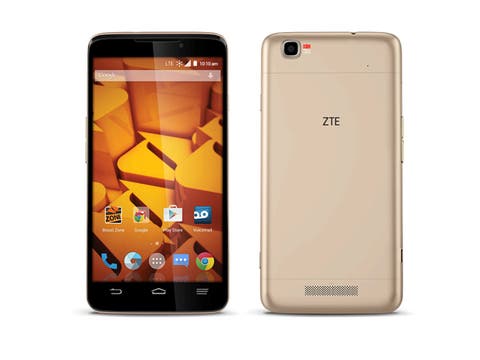ZTE and US carrier Boost Mobile teamed up to offer the Boost Max in 2014, and the company is back to create its successor. Branded the ZTE Boost Max+, the new Boost Max offers much of the same experience spec-wise, with a few improvements.
First, let’s get this out of the way: the ZTE Boost Max+ brings back the 5.7-inch, IPS LCD panel with an HD resolution of 1280 x 720, which remains unchanged from the original Boost Max released in 2014. The processor and RAM see improvements, however, with the Boost Max+ featuring a quad-core Qualcomm Snapdragon 410 processor, while the original Boost Max had a 1.2Ghz, dual-core Snapdragon 400 processor. The Boost Max+ has 2GB of RAM whereas the first Boost Max had only 1GB of RAM. The storage of the ZTE Boost Max+ has doubled as well, with 16GB of minimum storage as opposed to the 8GB of storage in the Boost Max from last year. Of course, expandable storage returns in the Boost Max+, so users need not worry about running out of storage space.
The 8MP rear camera (with its 1080p video recording) and the 1MP front camera with its 720p recording return on the Boost Max+, which means that you should get the same solid experience from this one as last year’s Boost Max. The battery, which was already excellent for a device such as the Boost Max, gets a 200mAh boost in the Boost Max+, going from 3,200mAh (Boost Max) to 3,400mAh (Boost Max+). LTE is not onboard with the new Boost Max+ (at least this model), but its 3G capabilities, combined with the rest of the package, will only cost $199 off-contract (as opposed to the original $299 price tag of last year’s 3G Boost Max).
As for the Boost Max+ OS update, the device will run Android 5.1 Lollipop out of the box, which is a contrast to last year’s Boost Max that ran on Android 4.1.2 Jelly Bean. Android Lollipop brings features such as a battery-saving mode, lock screen notifications, and more.
ZTE has a winner on its hands with the Boost Max+, and its battery size dwarfs most phablet-sized smartphones on the market (iPhone 6 Plus’s 1860mAh battery, the Galaxy Note 4’s 3220mAh, Nexus 6’s 3,220mAh, and even the Sony Xperia Z4). There are exceptions to this rule, however, with the Motorola Droid Turbo (a.k.a. Moto Maxx) having a 3,900mAh battery, the Galaxy S6 Active on US carrier AT&T that houses a 3,500mAh battery, and the upcoming Galaxy Note 5 that has been rumored to house a 4,100mAh battery. At the same time, however, all of these phablet smartphones will cost at least $199 with a two-year carrier agreement; the iPhone 6 Plus, however, will mandate $299 with a two-year agreement, as will Samsung’s Note 4 (although the 2014 phablets will decrease in price when the 2015 models are announced).
If you want more for your money, and you don’t need or want the brightest screen resolution, best camera, and a feature-packed experience, the Boost Max+ may just be the smartphone for you. It is an impressive handset for a budget-friendly price.
[ Source]